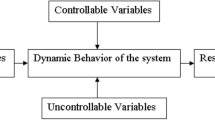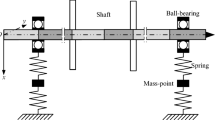Abstract
The dynamic characteristics of system, namely the damping ratio, natural frequency, and mode shape are extracted from the frequency response function (FRF). Obtaining dynamic characteristics through FRF on large rotor system is impractical owing to safety and cost. Therefore, the dimensional scale method to predict FRF on a large rotor system is proposed. The method begins by deriving the scaling factor of FRF followed by its validation using finite element (FE) and transfer function modeling. In this case, the transfer function completes the FE modeling to describe the FRF system and compensates the lack in FE modeling in dealing with complex support and shape. Assuming the damping ratio is constant, the characteristic of dimensional analysis through FRF is obtained and the complexity of the proposed method is also discussed.
Similar content being viewed by others
Abbreviations
- FRF :
-
Frequency response function
- p :
-
Scaling factor
- FEM :
-
Finite element method
- TF :
-
Transfer function
- k 1,2 :
-
Stiffness
- c 1,2 :
-
Damping coefficient
- m 1,2 :
-
Mass
References
W. E. Baker, F. T. Dodge and P. S. Westine, Similarity Methods in Engineering Dynamics, Theory and Practice of Scale Modeling, Elsevier Science Publisher (1991).
H.-K. So, T.-H. Jo, Y.-H. Lee, D.-W. Kim, B.-C. Koo and D.-H. Lee, Experimental analysis of HRSG for simulating internal flow behavior using Euler and swirl similitudes, Journal of Mechanical Science and Technology, 32 (10) (2018) 5031–5038.
C. P. Coutinho, A. J. Baptista and J. D. Rodrigues, Reduced scale models based on similitude theory: A review up to 2015, Engineering Structures, 119 (2016) 81–94.
Y. H. Tyng, O. Z. Chao, K. K. Kuan, Z. Ismail, A. G. A. Rahman and C. W. Tong, Similitude study of an in-service industrial piping system under high flow induced vibration, Journal of Mechanical Science and Technology, 31 (8) (2017) 3705–3713.
Y. Zhu, Y. Wang, Z. Luo, Q. Han and D. Wang, Similitude design for the vibration problems of plates and shells: A review, Frontiers of Mechanical Engineering, 12 (2) (2017) 253–264.
J.-J. Wu, Prediction of lateral vibration characteristics of a fullsize rotor-bearing system by using those of its scale models, Finite Elements in Analysis and Design, 43 (10) (2007) 803–816.
J.-J. Wu, Prediction of the torsional vibration characteristics of a rotor-shaft system using its scale model and scaling laws, International Journal of Mechanical, Aerospace, Industrial, Mechatronic and Manufacturing Engineering, 9 (2) (2015) 229–235.
H. Miao, C. Zang and M. I. Friswell, Dynamic similarity design method for an aero-engine dualrotor test rig, Journal of Physics: Conference Series, 744 (2016) 012109.
A. M. Iglesias, Investigating various modal analysis extraction techniques to estimate damping ratio, Master Thesis, Blacksburg, Virginia: Virginia Polytechnic Institute and State University (2000).
O. Omar, N. Tounsi, E.-G. Ng and M. A. Elbestawi, An optimized rational fraction polynomial approach for modal parameters estimation from FRF measurements, Journal of Mechanical Science and Technology, 24 (3) (2010) 831–842.
T. L. Schmitz and K. S. Smith, Mechanical Vibrations, North Calorine, USA: Springer (2012).
Z. Fei, S. Tong and C. Wei, Investigation of the dynamic characteristics of a dual rotor system and its start-up simulation based on finite element method, Journal of Zhejiang University Science A, 14 (4) (2013) 268–280.
J. Metsebo, N. Upadhyay, P. K. Kankar and B. R. Nana Nbendjo, Modelling of a rotor-ball bearings system using Timoshenko beam and effects of rotating shaft on their dynamics, Journal of Mechanical Science and Technology, 30 (12) (2016) 5339–5350.
M. Hashemi and M. Asghari, Investigation of the small-scale effects on the three-dimensional flexural vibration characteristics of a basic model for micro-engines, Acta Mechanica, 226 (9) (2015) 3085–3096.
T. A. Harris, Advance Concepts of Bearing Technology, Fifth Ed., CRC Press (2006).
M. Karlberg, Approximated stiffness coefficients in rotor systems supported by bearings with clearance, International Journal of Rotating Machinery (2010) 1–5.
E. Kurvinen, J. Sopanen and A. Mikkola, Ball bearing model performance on various sized rotors with and without centrifugal and gyroscopic forces, Mech. Mach. Theory, 90 (2015) 240–260.
Y. Guo and R. G. Parker, Stiffness matrix calculation of rolling element bearings using a finite element/contact mechanics model, Mechanism and Machine Theory, 51 (2012) 32–45.
H. Wang, J. Gong and G. Chen, Characteristics analysis of aero-engine whole vibration response with rolling bearing radial clearance, Journal of Mechanical Science and Technology, 31 (5) (2017) 2129–2141.
B. Schwarz and M. Richardson, Proportional damping from experimental data, Conference Proceedings of the Society for Experimental Mechanics Series (2013) 179–186.
S. Adhikari, Damping modelling using generalized proportional damping, Journal of Sound and Vibration, 293 (1-2) (2006) 156–170.
Acknowledgments
This work is supported by the SAINTEK Scholarship Program, the Ministry of Research and Higher Education, Republic of Indonesia.
Author information
Authors and Affiliations
Corresponding author
Additional information
Dyah Kusuma Dewi received Master Degree at Institut Teknologi Bandung (ITB), Indonesia. She works as a Researcher at the Agency for the Assessment and Application of Technology and is currently pursuing her Ph.D. in the Dynamic Laboratory, Mechanical Engineering Department, Faculty of Mechanical and Aerospace Engineering, ITB.
Rights and permissions
About this article
Cite this article
Dewi, D.K., Abidin, Z., Budiwantoro, B. et al. Dimensional analysis of a rotor system through FRF using transfer function and finite element methods. J Mech Sci Technol 34, 1863–1870 (2020). https://doi.org/10.1007/s12206-020-0407-x
Received:
Revised:
Accepted:
Published:
Issue Date:
DOI: https://doi.org/10.1007/s12206-020-0407-x




